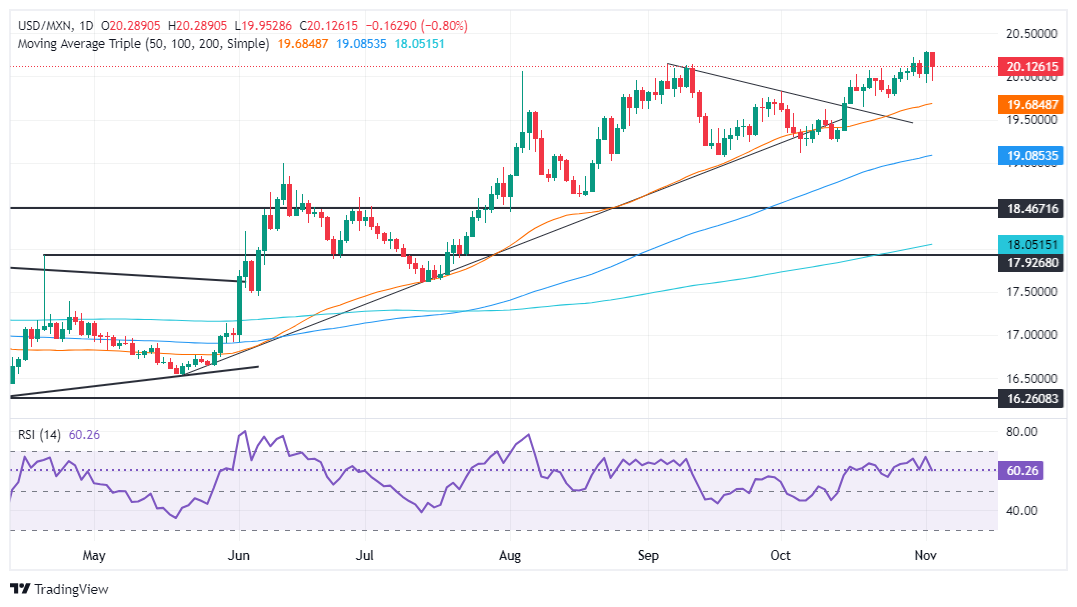- Mexican Peso Strengthens Despite Weak National Data; Gross Fixed Investment reaches its lowest level since February 2021.
- The Supreme Court of Mexico will discuss the proposed judicial election amid political tensions.
- Trump’s tariff threat and the Fed’s possible rate cut increase the volatility of the Peso.
The Mexican Peso appreciates against the Dollar during the North American session, registering gains of more than 0.70% amid uncertainty over the outcome of the US presidential elections. Data from Mexico showed that Gross Fixed Investment plummeted sharply, while Factory Orders in the United States (US) improved but remained in contraction territory. USD/MXN is trading at 20.12 after hitting a daily high of 20.16.
August Gross Fixed Investment in Mexico fell to its lowest level since February 2021, due to lower investment in construction and a sharp drop in non-residential construction. Meanwhile, the National Institute of Statistics, Geography and Informatics (INEGI) is expected to announce October inflation data, which is expected to moderate further, according to a Reuters poll.
Aside from this, on November 5, the Supreme Court of Mexico will begin discussing a proposal from Supreme Court Justice Juan Luis González Alcántara Carranca. According to The New York Times, his proposal is simple: “Challengers for the Supreme Court and other high courts would have to stand for election. But thousands of other judges, appointed based on years of training, would remain in office.”
Meanwhile, Mexican President Claudia Sheinbaum said she would wait to see how the judges vote, although she added, “I was elected by the people of Mexico, and eight ministers cannot be above the people.”
The Mexican currency is likely to continue to be affected by internal political turmoil and the outcome of the US presidential election. Recently, Republican candidate, former President Donald Trump, said he would impose 25% tariffs on all imports from Mexico if the current government does not attack the drug cartels and stop immigration from Central and South America.
US Factory Orders contracted in September for the second consecutive month, although they improved compared to August figures.
USD/MXN traders await the Federal Reserve (Fed) monetary policy decision on November 6-7, in which the Fed is expected to reduce borrowing costs by 25 bps. After that, Fed Chair Jerome Powell’s press conference will be scrutinized by investors for clues about the Fed’s policy path.
Daily Market Summary: Mexican Peso Ignores US Election Concerns
- The USD/MXN remains adrift from the political turmoil in Mexico following the approval of the controversial judicial reform.
- Mexico’s Gross Fixed Investment (GFI) fell -1.9% monthly in August, from an expansion of 1.8% in July. In annual terms, investment fell -1.9% in the same period, from 6.4%.
- On November 7, Mexico’s inflation rate for October is expected to increase from 4.58% year-on-year to 4.72% year-on-year. The underlying inflation rate for the same period is estimated to drop from 3.91% to 3.86%.
- The US Census Bureau announced that US Factory Orders in September contracted -0.5% more than expected at -0.4%, although they improved compared to the drop in – 0.8% in August.
- Even though last week’s US Nonfarm Payrolls report was disastrous, traders remain skeptical that the Federal Reserve will cut rates by more than 25 basis points.
- The Federal Open Market Committee (FOMC) is expected to cut rates by 25 bps on November 7.
- Data from the Chicago Board of Trade, via the December federal funds rate futures contract, shows that investors are estimating 50 bp easing by the Fed by the end of the year.
USD/MXN Technical Outlook: Mexican Peso Rises as USD/MXN Falls Below 20.20
The USD/MXN bullish trend remains intact, although sellers intervened during the day. If they want to take the price action lower, they must reclaim the 20.00 figure, which would pave the way for a further decline. In that case, the pair’s first support would be the October 24 daily low of 19.74, ahead of the 50-day SMA at 19.66. Once those levels are broken, the next support would be the October 4 cycle low of 19.10.
Conversely, if USD/MXN resumes its uptrend, the first resistance would be the November 1 high at 20.29. A break of the latter will expose the figure of 20.50, followed by the September 28, 2022 high at 20.57 and the August 2, 2022 peak at 20.82. Once surpassed, the next stop would be the March 8, 2022 high at 21.46.
The Mexican Peso FAQs
The Mexican Peso (MXN) is the most traded currency among its Latin American peers. Its value is largely determined by the performance of the Mexican economy, the policy of the country’s central bank, the amount of foreign investment in the country and even the levels of remittances sent by Mexicans living abroad, particularly in the United States. . Geopolitical trends can also affect the MXN: for example, the nearshoring process (or the decision by some companies to relocate manufacturing capacity and supply chains closer to their home countries) is also seen as a catalyst for the currency. Mexican, as the country is considered a key manufacturing center on the American continent. Another catalyst for the MXN is oil prices, as Mexico is a key exporter of the raw material.
The main objective of Mexico’s central bank, also known as Banxico, is to keep inflation at low and stable levels (at or near its target of 3%, the midpoint of a tolerance band between 2% and 4%. %). To do this, the bank establishes an appropriate level of interest rates. When inflation is too high, Banxico will try to control it by raising interest rates, which makes borrowing more expensive for households and businesses, thus cooling demand and the economy in general. Higher interest rates are generally positive for the Mexican Peso (MXN) as they lead to higher yields, making the country a more attractive place for investors. On the contrary, lower interest rates tend to weaken the MXN.
The publication of macroeconomic data is key to evaluating the state of the economy and can have an impact on the valuation of the Mexican peso (MXN). A strong Mexican economy, based on high economic growth, low unemployment and high confidence is good for the MXN. Not only does it attract more foreign investment, but it may encourage the Bank of Mexico (Banxico) to raise interest rates, particularly if this strength is accompanied by high inflation. However, if economic data is weak, the MXN is likely to depreciate.
As an emerging market currency, the Mexican Peso (MXN) tends to rise during periods of risk, or when investors perceive overall market risks to be low and are therefore eager to engage in investments that carry higher risk. . Conversely, the MXN tends to weaken in times of market turbulence or economic uncertainty, as investors tend to sell riskier assets and flee to more stable safe havens.
Source: Fx Street
I am Joshua Winder, a senior-level journalist and editor at World Stock Market. I specialize in covering news related to the stock market and economic trends. With more than 8 years of experience in this field, I have become an expert in financial reporting.








